

Chinese Medicine Demystified (Part I): A Case of Mistaken Identity. Note: This is the first article in an ongoing series.
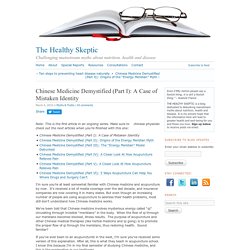
Make sure to check out the next articles when you’re finished with this one: I’m sure you’re at least somewhat familiar with Chinese medicine and acupuncture by now. It’s received a lot of media coverage over the last decade, and insurance companies are now covering it in many states. Asian Medicine Zone » Asian Medicine Zone. Between Heaven & Earth ACUPUNCTURE AND HERBS - Home. Spirit Path Press - Destiny, Healing, and Medicine. Exploring the history and philosophy of Chinese medicine. The Alchemist's Archives — The Wandering Cloud.
Axis Mundi Healing Arts & Divination. It’s a curious and essential feature of our bodies that the outside world passes through us in a long, tortuous tube.
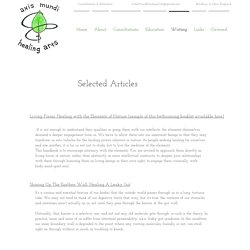
We may not tend to think of our digestive tracts that way, but it’s true: the contents of our stomachs and intestines aren’t actually in us, not until they pass through the barrier of the gut wall. Naturally, that barrier is a selective one, and not just any old molecule gets through: or such is the theory. In practice, more and more of us suffer from intestinal permeability, a.k.a. leaky gut syndrome. In this condition, our inner boundary wall is degraded to the point where any visiting molecules, friendly or not, can stroll right on through without so much as troubling to knock... ...Through fire’s portal we access the transcendent bliss of communion, and it is through this experience of spirit that we area able to orient ourselves to something greater than our own wants and needs.
The Twelve Spirit Points of Acupuncture. Huo shen Pai. Aowen Chinese Medicine. Chronopuncture. Moxibustion. 5 elements Worsley. Li Shi Zhen. Tung acupuncture. Formation à distance. Hara diagnosis. Jeffrey Yuen Classical daoist acupuncture. Facebook medecine chinoise. Neijing. Acupuncture japonaise. Pharmacopea chinesa.
Zhang zhongjing - Shan Han Lun - Golden Cabinet. Livres Medecine chinoise. Thoughts along the way: Recommended Reading for all Practitioners of TCM: Part 1. With the current air of dissatisfaction surrounding the modern Chinese medical curriculum, I have spoken at some length with various practitioners and instructors on the subject of what a true reading list of traditional Chinese medicine should look like.
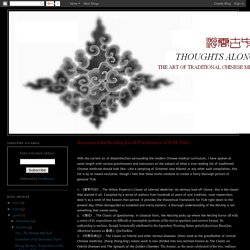
Like a sampling of 'Greatest Jazz Albums' or any other such compilation, this list is by no means exclusive, though I feel that these works combine to create a fairly thorough picture of genuine TCM. 1. 《黄帝内经》, The Yellow Emperor's Classic of Internal Medicine: An obvious lead off choice, this is the classic that started it all. Compiled by a series of authors from hundreds of years of oral tradition, most researchers date it as a work of the Eastern Han period.
It provides the theoretical framework for TCM right down to the present day. The Chinese Medicine Database. 談允賢 Tan Yunxian. 醫易 Yi Jing and Medicine. EBRAMEC - CIEFATO. Exploring the history and philosophy of Chinese medicine. Chinese Palmistry - TCM: traditional medicine & Palm Reading from China! Traditional Chinese palm reading is deeply rooted in yin yang theory, five phase theory, and the eight trigrams of the Yi Jing (Classic of Change).
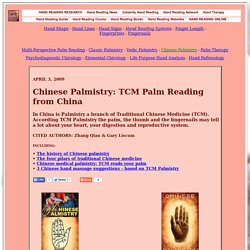
As far as the written record is concerned, palmistry in China traces its earliest origins to the Zhou Dynasty (1122-770 BCE) when it was then both popular and widespread. The earliest important Chinese discussion of palmistry is found in the Gu Ge Pian (Writings on the Skeleton), also known as Gu Xiang (Appearances on Bones), written by the scholar Wang Chong in the late part of the Han Dynasty (206 BCE-220 CE). According to Wang: Most premodern books on palmistry were not just about palmistry. Rather, sections on palmistry tended to be found as chapters in books on bodily prognostication in general.
Treating Fever Using Classical Thinking from the Shang Han Lun. Zhang Zhongjing.
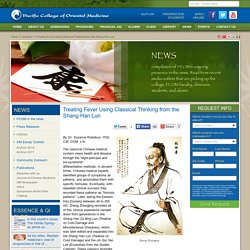
By Dr. Suzanne Robidoux, PhD, CM, DOM, LAc The classical Chinese medical system views health and disease through the “eight-principle and six-syndrome” differentiation methods. In ancient times, Chinese medical experts identified groups of symptoms as patterns, and associated them with specific formulas. Eventually, with repeated clinical success they recorded these patterns as “formula patterns”. To begin to understand the philosophy and clinical approach of classical thinking, we must open our minds to a different way of viewing health and diseases. Bienvenue sur le site de la Fondation Cornelius Celsus. 神明 shen ming seminars: Lonny Jarrett. Lonny Jarrett has been a leading scholar in the field of Chinese medicine since 1980.

He is a Fellow of the National Academy of Acupuncture and Oriental Medicine and a founding board member of the Acupuncture Society of Massachusetts. He teaches and publishes widely on the inner tradition of Chinese medicine and Chinese pulse diagnosis. Mr. Nourishing Destiny. Tan Wu Bian - Formation en Acuponcture par Dr. Tan. Rooting the Spirit - Sun Si Miao's 'Ghost Points. Dr. Phil Garrison, DAOM. Sun Simiao, God of Medicinals and Master of Nurturing Life. Back Shu Acupuncture Points - Acupuncture Services of Central New York. A collection of twelve very important acupuncture points called the Back Shu, or Back Transporting points are located on the Bladder meridian along the spine.

There is a Back Transporting point for each of the six yin organs and each of the six yang organs. They are called “transporting” points because it is said that they transport “Qi” to the inner organs. These acupuncture points are located on the inner Bladder meridian path, which is about an inch and a half from the mid-line of the spine. The Back Transporting points affect the organs directly and are especially important in the treatment of chronic diseases. Each of the points is named after the organ that it is associated with. The Back Shu points are acupuncture points where the Qi and Blood of a particular organ meet. The Back Shu points are stimulated with a variety of techniques.
About the Author: Joyce Marley is a licensed acupuncturist who provides acupuncture therapy in New Hartford, NY. Edward Neal, MD. Dr.
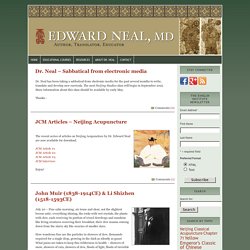
Neal has been taking a sabbatical from electronic media for the past several months to write, translate and develop new curricula. The next Neijing Studies class will begin in September 2015. More information about this class should be available by early May. Thanks - The recent series of articles on Neijing Acupuncture by Dr. JCM Article #1JCM Article #2JCM Article #3JCM Interview. Centering the Umbilical Pulse and Akabani Testing. By Neil Gumenick, MAc (UK), LAc, Dipl.

Ac This article will address two very specific and important treatment protocols: the Umbilical Pulse and the Akabani Test, both of which can be incorporated with any style of practice. If the Umbilical Pulse (AKA "Center Pulse") is off center, or if any of the meridians are bilaterally imbalanced (known as an "Akabani Imbalance"), it will substantially affect the outcome of treatment. Edward Neal, MD. Practitioner Resources - Dr. Peter Borten.
Here are a handful of resources I’ve developed that may be of use to medical practitioners in the clinic.
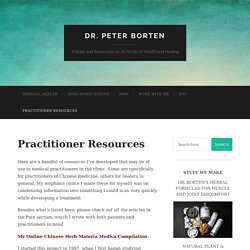
Some are specifically for practitioners of Chinese medicine, others for healers in general. My emphasis (since I made these for myself) was on condensing information into something I could scan very quickly while developing a treatment. Besides what’s listed here, please check out all the articles in the Pain section, which I wrote with both patients and practitioners in mind. Acupuncture Masters. Acupuncture - Four Flowers. Monkey Press. Mazin Al-Khafaji - Avicenna. Mazin Al-Khafaji Doctor of Chinese Medicine (Shanghai, China); FRCHM (Fellow of the Register of Chinese Herbal Medicine); founder of Avicenna Centre for Chinese Medicine.
Mazin is recognised as one of the leading experts in TCM and Modern Chinese Medicine in the world. He has treated unusual and difficult diseases with great success for the last 27 years, and has a particular interest in skin, auto-immune & allergic disease. Mazin started his studies in Chinese medicine and the Chinese language in 1979. He graduated as an acupuncturist in the UK in 1983 and then continued his studies in China where he was awarded the first Sino-British scholarship to study medicine alongside Chinese students. TCM Kongress Rothenburg o.d.T. - Startseite. Blog Archives - Zev Rosenberg. » Teachings - Soma Devi. Médecins célèbres… depuis l'Egypte des pharaons… jusqu'au noyau de la création. Découvrir: Hippocrate. L'acupuncture expliquée à tous. Acupractitioner21. Club Masaje UNAM: MA DAN YANG. Class notes, study guides, handouts. Présentation - Partageons les points. Techniques de moxibustion – jiu fa 灸法 - M-Chinese Corner. TUINA AN MO. Dien Chan: multiréflexologie du Pr Bùi Quôc Châu - Cours certifiés de réflexologie faciale.
Advanced Pulse Diagnosis Acupuncture, Traditional Chinese Medicine, Classic of Difficult Issues, Nan-Jing, Secret of Pulse Diagnosis, Acupuncture Pulse Balance,脈診, 針, 脈, 脈診断, pulse diagnosis seminars, semin - Home. TCM Herbal formulas - Acupuncture & Traditional Chinese Medicine information (Vancouver, Chinese herbal medicine, tuina massage, Chinese herbs, pictures, women's health, Chinese medicine history, common disease treatment, acupuncture theory, points), webl. Links. Méridien — Psiram. Les méridiens sont dans la médecine traditionnelle chinoise (MTC) de présumés canaux de l'énergie de l'homme sur la surface de la peau, dans lesquels la dite énergie de vie Chi (ou Ch'i, Qi, Ki) circulerait. Les méridiens jouent un rôle dans l'acupuncture, l'acupressure, la moxibustion[1] (une technique de stimulation par la chaleur des points d'acupuncture qui peut s'effectuer à l'aide du bout incandescent d'un cigare), le Shiatsu, l'EFT, EAV et la kinésiologie.
Etirements_des_meridiens.pdf. La prolongation des méridiens selon Masunaga : docomarseille. J'ai trouvé dans le cadre de l'apprentissage, qu'il serait plus simple de faire plusieurs cartes avec chaque prolongation, des yins et des yangs des bras et des jambes regroupées. vous trouverez donc 4 dessins représentants respectivement :
La réalité anatomique des méridiens. Médecine traditionnelle chinoise MTC. Docs, MTC, Dr Genming HUANG. Forum Institut Franck Calland. Energétique. ClassicalChineseMedicine.org. Acupuncture School at Dragon Rises College of Oriental Medicine. Yin Yang Podcast. Tontontattou. Tableaux pathologiques de la rate (Maciocia) flashcards. Acupuncture-formation-localisation-points-cours-généraux. Acupuncture-formation-localisation-points-cours-généraux. Les points psychiques du meridien du poumon. Par Philippe Sionneau. 36E chez le chien. Les Techniques Traditionnelles Chinoises. La Moxibustion. Suivant la baisse de la température de l’hiver, plus en plus de personnes tombent malade.
Maux de tête, le nez qui coule, fièvre, la toux etc. Le rhume est dû à l’affaiblissement du corps, et le manque de force pour lutter les maladies. Quand le climat subit des modifications, la capacité de combattre les maladies du corps humain n’arrive à s’adapter à ces changements. Les maladies vont alors profiter de notre peau, les pores, la bouche et le nez pour entrer dans nos poumons d’abord, et notre corps, c’est ainsi que nous attrapons un rhume.
Le rhume et les autres maladies possèdent chacun leur propre cause. Donc la règle de base de ne pas tomber malade, selon les théories de la médecine chinoise, il faut consolider la bonne force. Tableau comparatif des caractéritiques des Méridiens réguliers et irréguliers. Trajet des meridiens flashcards. Choain-4025. Pernice-93998. Meridienscurieux.pdf. Nguyen-35740. Oury-19109. Les jing bie : les méridiens distincts © Dr Jean-Marc STEPHAN. Shonishin - Acupuncture and herbal medicine - Medical and complementary health practitioners. Thomas Wernicke's authoritative book is one of the first resources in English on Shonishin, a non-invasive form of acupuncture developed specifically to respond to the needs of children. With its safe, quick and effective treatments, Shonishin is increasingly catching the attention of therapists world-wide.
Covering the history, theory and clinical practice, Wernicke explores how Shonishin is used with young children, from babies and toddlers to school-age children, to treat a range of behavioural issues and physical conditions such as KISS syndrome, allergies and asthma. He also examines how the techniques can be adapted for use with adults and older people to provide an alternative, non-invasive treatment. With access to downloadable handouts that can be used with patients, and international case studies that demonstrate its effectiveness, his book provides a complete and practical handbook on Shonishin for existing practitioners.
Xinglin Institute Classical Chinese Medicine Program. Home. The Chinese Medicine Database. The knowledge base for Chinese medicine is incredibly vast. There are thousands of medical texts which were written in the time span of the Han to the Qing Dynasties. These books make up the core knowledge of pre-modern Chinese medicine. Sadly, many of these books have not been translated into English, and there are thousands which never will be. This is no small feat, as each small to medium text takes a translator at least a year to translate, and larger texts take even longer. This is a labor of love, born from the desire to read the material that our teachers have read, and to drink from the source. Our mission is to translate these texts in a literal way. Most scholars will agree that a literal translation is the starting point for texts where the source material is in a different language.
Once a literal translation has been created, and is on the market, then it is up to our community to tease out the layered meanings within the text. Differentiation of Syndromes According to the Six Stages. Differentiation of syndromes according to the 6 channels originally appeared in the Traditional Chinese Medicine classic called the "Shang Han Lun", which can be loosely translated as "On Cold Damage". It was written by Zhang Zhong Jing in the late Han Dynasty, circa 20-200 A.D. The original text was then divided into two texts, one being the "Shan Han Lun" which focused on external conditions, and the other being the "Jin Kui Yao Lue" which focuses on internal conditions. Many of the herbal formulas from these two texts are not only very elegant, but still useful today. Tai Yang (Initial Yang) Syndromes The Tai Yang syndrome corresponds to the initial invasion of the external Cold Evil through the pores and interstices of the skin.
General symptoms: Headache and Stiff NeckChills and FeverFloating Pulse The stiff neck and headache will be located in the Tai Yang (Bladder and Small Intestine Channel) areas of the body. Neijing Studies and Classical Acupuncture: 1 Year Certificate Program. The Neijing Studies and Classical Acupuncture 1-year Certificate Training was designed to give student participants an in-depth introduction to the theories, terminology and clinical techniques of the foundational Chinese medical text the Huangdi Neijing. This course is given through 26-online lectures along with 12 days of on-site clinical practicum sessions. These classes are given by the Xinglin Institute for Early East Asian Medical Research in conjunction with the Academy for Oriental Medicine at Austin (AOMA) in Austin, Texas. Online classes will be given via Adobe virtual classroom.
In-person practicum trainings will be held at the AOMA campus in Austin, Texas. Upon the successfull completion of this training, participants will be awarded a certificate of completion in Neijing Studies by the Xinglin Institute. The curriculum for the class is based on previous versions of the Introduction to Neijing Studies course (taught by Dr.